Straw Bale Insulation – Straw Bale Houses More Comfortable?
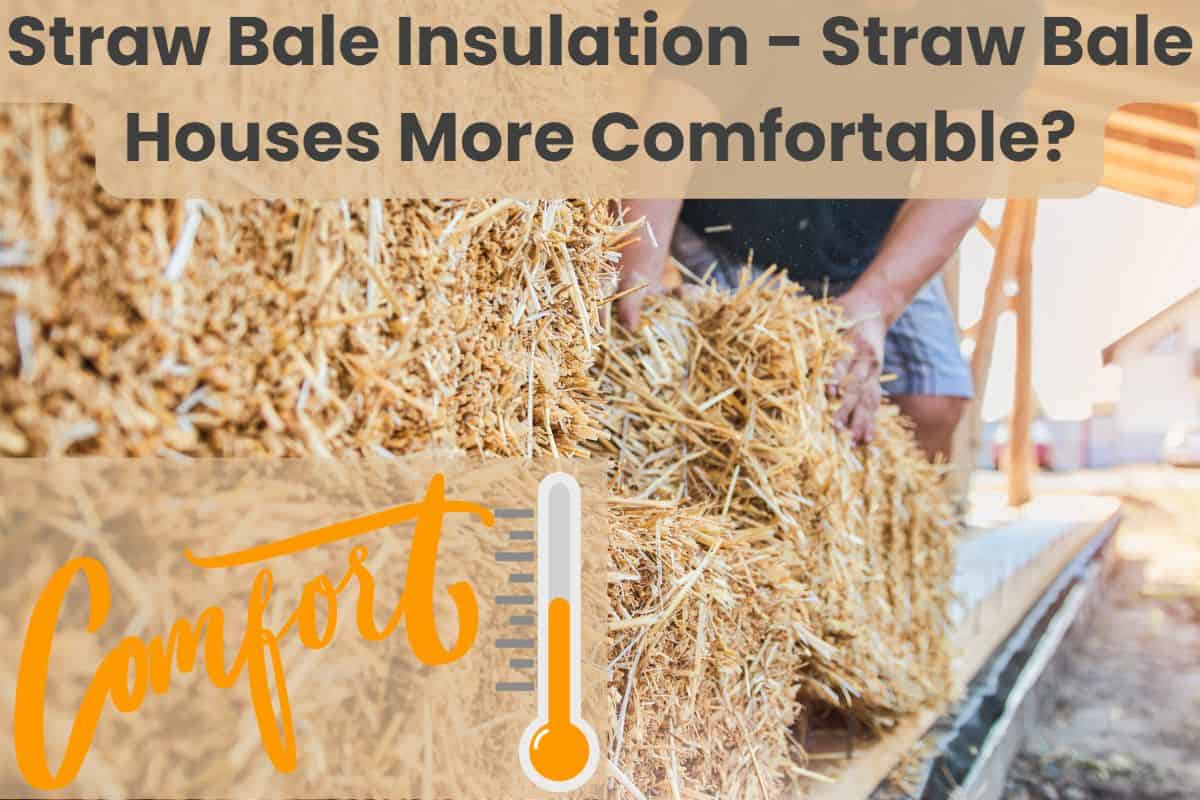
If you’re considering building a new house or renovating an existing one, insulation is likely one of the top items on your list.
Adequate insulation is crucial for comfortable indoor temperatures and good energy efficiency.
While conventional insulation materials like fiberglass and foam have been popular choices, there is growing interest in sustainable materials like straw bale insulation.
Straw bale insulation is a type of insulation made from compressed straw bales. These straw bales are typically made from wheat, rye, oats, barley, or rice straw. Due to their high R-values per inch, straw bales make straw bale houses more comfortable and energy efficient.
In the rest of this article, I’ll discuss the types of straw bale insulation, their R-values, and their durability.
I’ll also cover the disadvantages of using straw bales for insulation to help you make an informed decision for your home. Let’s get started!
The Making of Straw Bale Insulation
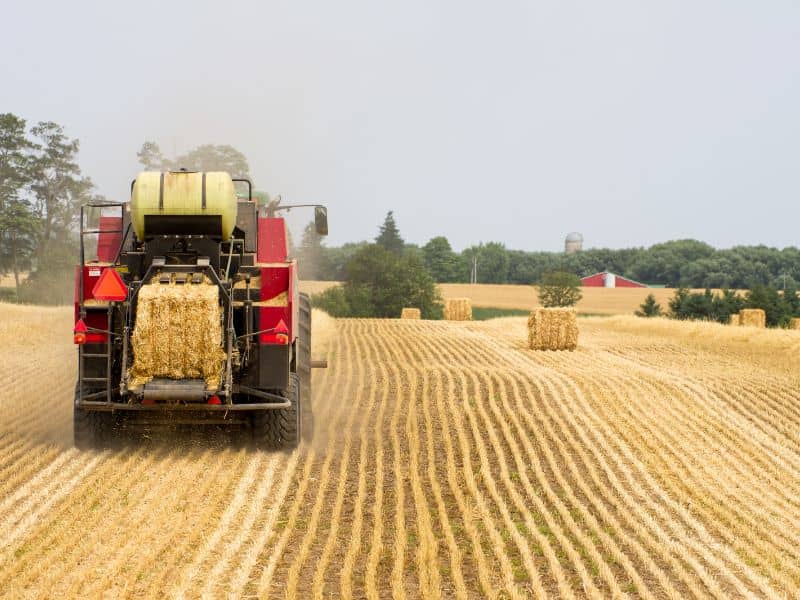
Before discussing the types of straw bale insulation, let’s look at how they are made.
Straw bale insulation is made by tightly compressing straw into rectangular (cuboid-shaped) bales.
In most cases, people use a baler to compress straw and bind the bales together with twine or wire.
After compression, the bales can be stacked like bricks and used to build walls.
Since straw bales are more susceptible to water damage, it’s advisable to cover the walls with a layer of breathable material like clay or lime plaster. This helps protect from moisture and pests while allowing some air movement.
It’s worth mentioning that covering your straw bale insulation with a non-vapor-permeable layer like cement-based stucco can be catastrophic. According to Science Direct, such a layer will seal the straw bales, leaving no room for moisture to escape.
Moisture accumulation within the straw bales exposes them to mold, mildew, and rot.
Types of Straw Bale Insulation
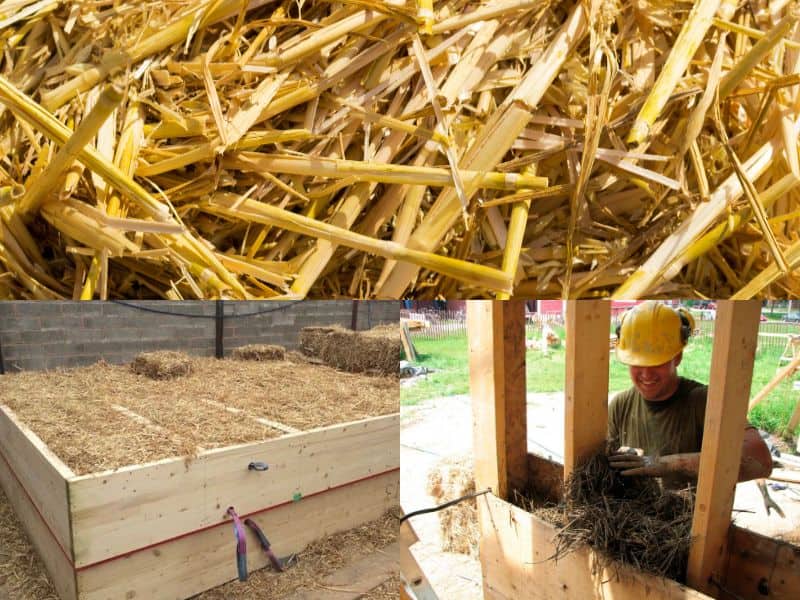
The following are the main types of straw bale insulation.
Loose Straw Insulation
This type of insulation is made from loose, uncompressed straw. The material is usually chopped into small pieces and packed between the house’s walls, attics, or floor joists.
Although loose straw insulation is easy to install, it has a lower R-value than other insulation types.
What’s more, loose straw insulation is more susceptible to fire. Since this type of insulation uses uncompressed straw, it can fuel a fire. Therefore, you must be extra careful with fire if you use loose straw insulation.
Baled Straw Insulation
Unlike loose straw insulation, baled straw insulation uses compressed bales to create a solid insulation layer. The bales are stacked between the wall studs or joists and then covered with vapor-permeable layers like lime plaster.
The compression process is essential for protection against fire. When straw bales are compressed, they become less combustible because the process removes spaces between the fibers. The lack of spaces between compressed straw fibers means there will be no oxygen to support combustion.
Baled straw insulation has a higher R-value than loose straw insulation, making it a better choice for energy efficiency. It’s also more durable and resistant to water damage, pests, and mold growth.
Prefabricated Straw Panel Insulation
Prefabricated straw panel insulation, also known as straw bale insulation panels, is designed and manufactured in a factory. The panels are made to fit into standard stud cavities in walls.
These panels are made from tightly compressed straw bales, which make them extremely dense and solid. As a result, they have an excellent R-value that provides great insulation.
Prefabricated straw panels also have an advantage when it comes to installation speed. They are designed to fit into the stud cavities in walls; therefore, there’s no need for cutting or fitting.
When it comes to fire resistance, prefabricated straw panels are your best bet. These panels are tightly compacted and compressed; thus, they offer superior protection against fire compared to loose and baled insulation.
Straw-Clay Insulation
Also known as light straw clay, this type of insulation is made by mixing straw with a clay or mud binder. The mixture forms blocks that are then stacked to form a wall.
Alternatively, the straw-clay mixture can be used as an insulating infill. In this case, the process starts by erecting wooden frameworks and then filling the gaps with straw-clay infill.
In terms of fire resistance, straw-clay insulation surpasses the above straw bale insulations. The clay binder used in this insulation increases its ability to resist fire.
Cellulose-Blown Straw Insulation
Cellulose-blown straw insulation combines cellulose fibers and shredded straw. The mixture is then sprayed into walls using a specialized blowing machine.
The cellulose fibers used in this type of insulation provide added fire resistance compared to loose straw insulation. Additionally, the cellulose-blown straw insulation has a higher R-value and superior air sealing capabilities.
Does Straw Bale Construction Make Houses Comfortable?
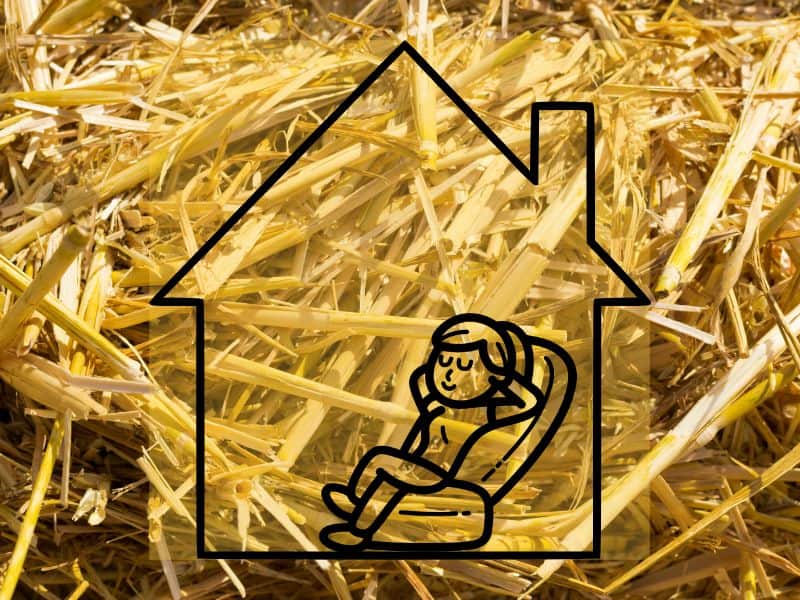
Straw bale insulation makes houses more comfortable due to its high R-values ranging between R-0.94 and R-2.38 per inch. These high R-values mean that straw bale building materials have high thermal resistance, a crucial factor in keeping a house warm in winter and cool in summer.
Moreover, straw bale insulation helps reduce air leakage, which can lead to drafts and cold spots. The good news is that these insulations are easy to install and are more eco-friendly than conventional building materials often used for insulation.
What happens when your house is sufficiently insulated with straw bales? You guessed it –reduced heating and cooling costs. The insulation lowers your heating and cooling costs by up to 75 percent.
What’s more, straw bale insulation has excellent acoustic properties that aid in soundproofing.
According to a study, a 20-inch thick straw bale wall had a 59.8 dBA sound transmission loss, illustrating the excellent soundproofing capabilities of this insulation. Therefore, it’s your go-to option for peace and quiet if you live in a noisy area.
Finally, straw bale insulation provides good protection against pests and mold growth and surprisingly good fire resistance.
The R-Value of Straw Bale Insulation

R-value is the measure of thermal resistance used to describe how effective an insulator is. The higher the R-value, the better it is at resisting heat flow.
The R-values for different straw bale insulations vary depending on the type and installation technique used.
It’s worth noting that the type of insulation technique determines the insulation’s thickness which affects the R-value. According to Science Direct, the thicker the insulation, the higher its R-value, and vice versa.
As I mentioned, straw bale insulation’s R-value ranges between R-0.94 and R-2.38 per inch. The variation is mostly brought about by the thickness.
Most straw bale houses have walls with thicknesses ranging between 25.5 and 35cm (10.04 and 13.78 inches). We can use these values to calculate the overall R-value of a straw bale wall.
For this calculation, we’ll use the mid-point of the R-value range for straw bale insulation per inch:
{ ( 0.94 + 2.38 ) ÷ 2 } = 1.66.
We’ll also use an average straw bale wall thickness in inches calculated below:
{ ( 10.04 + 13.78 ) ÷ 2 } = 11.91 inches.
Therefore, the approximate R-value of an “average” straw bale wall will be:
( 11.91 × 1.66 ) = 19.77.
This calculation is in line with the findings of a study by the American Council for an Energy-Efficient Economy (ACEEE) which found that the R-value of straw bale walls ranges between R-17 and R-54. The thicker the wall, the higher its R-value.
Building Codes for Straw Bale Insulation
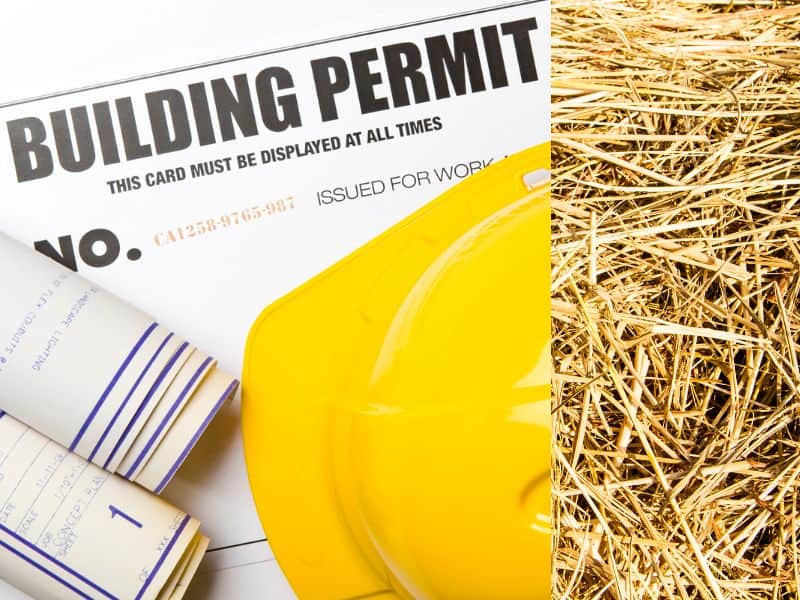
According to the National Institute of Standards and Technology, building codes are in place to protect public health, safety, and general welfare. They are the laws that set the minimum requirement for the design and construction of:
- Structural systems
- Plumbing
- HVAC
- Natural gas systems
Straw bale insulation and construction are no different, and there are building codes that must be followed to ensure the safety of your home.
The International Residential Code (IRC) has set strict guidelines that must be met for straw bale insulation and construction.
A point worth mentioning is that these straw bale insulation building codes vary from state to state and country to country. Therefore, you might find a certain requirement that does not apply to your locality. It’s important to confer with the relevant authorities to get the codes applicable to you.
The following are some of the building codes that apply to straw bale insulation and construction:
- Shape: The bales must be rectangular.
- Size: Height and thickness of at least 12 inches (304.8 mm).
- Moisture content: The moisture content shall not exceed 20% of the bale’s weight at the time of applying the first plaster.
- Dry density: At least 6.5 pounds per cubic foot (104 kg/cubic meter).
- Types of straw: Oat, wheat, rice, rye, or barley.
Please visit IRC for more information about straw bale building code requirements.
Disadvantages of a Straw Bale House
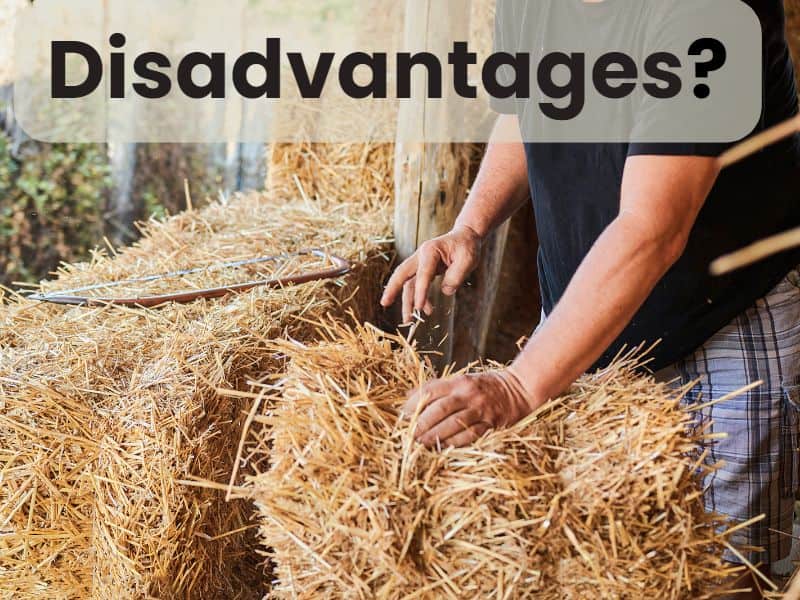
What are the disadvantages of straw bale building?
We’ve covered a lot of the benefits of straw bale construction. However, as with anything, there are some drawbacks to these building materials. They include:
- A straw house is susceptible to moisture damage if not protected properly.
- Most builders are unfamiliar with this building material, causing an obstacle to its use.
- Compared with conventional construction methods, straw bale houses have thicker walls, reducing the amount of floor space available.
- They need care to keep rodents and other small animals at bay.
Frequently Asked Questions
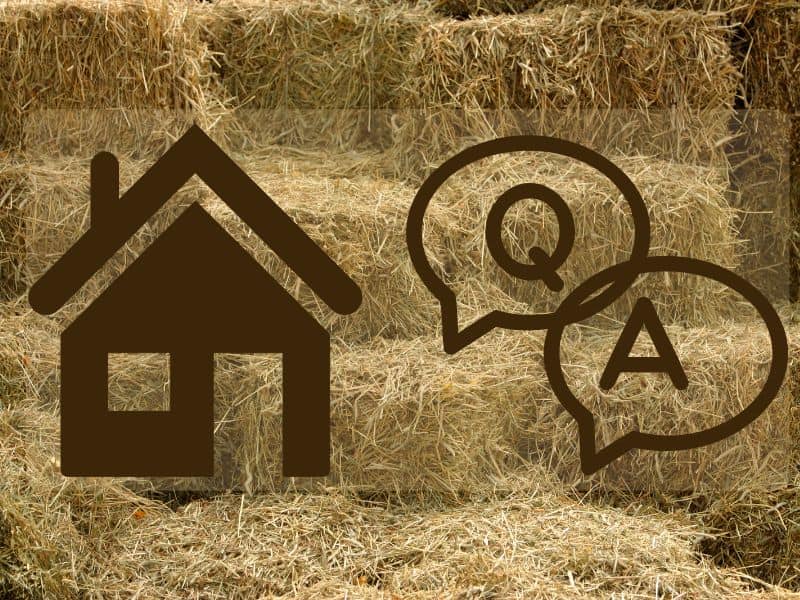
Are straw bale houses energy efficient?
Straw bale houses are energy efficient because straw bale walls have a high R-value (R-17 to R-54). The higher a material’s R-value, the more energy efficient it is due to reduced heat flow.
Are straw bales a good insulator?
Straw bales are a good insulator due to the high number of air pockets they contain. Trapped air is an excellent thermal insulator that doesn’t allow heat flow.
How long does straw bale insulation last?
Straw bale insulation can last up to 100 years. However, this is not always guaranteed. Care must be taken to prevent moisture accumulation within the bales to prolong life as much as possible.
Is hay or straw better for insulation?
Straw is better than hay for insulation due to its stiff and hollow structure. The structure traps air pockets that act as a barrier to the flow of heat. Hay is also used as animal feed and can attract pests, and is more likely to decompose over time. Hay must not be used in construction, only straw.
Final Thoughts
Straw bale insulation is an excellent way to insulate homes.
The straw’s structure traps air pockets which help break the flow of thermal energy, giving it excellent thermal insulation properties. Therefore, it is an excellent insulation material to conserve energy and reduce heating and cooling bills.
Will a straw bale home meet your needs? Check out this article that discusses the pros and cons of straw bale homes to see if they are a good fit for you.







